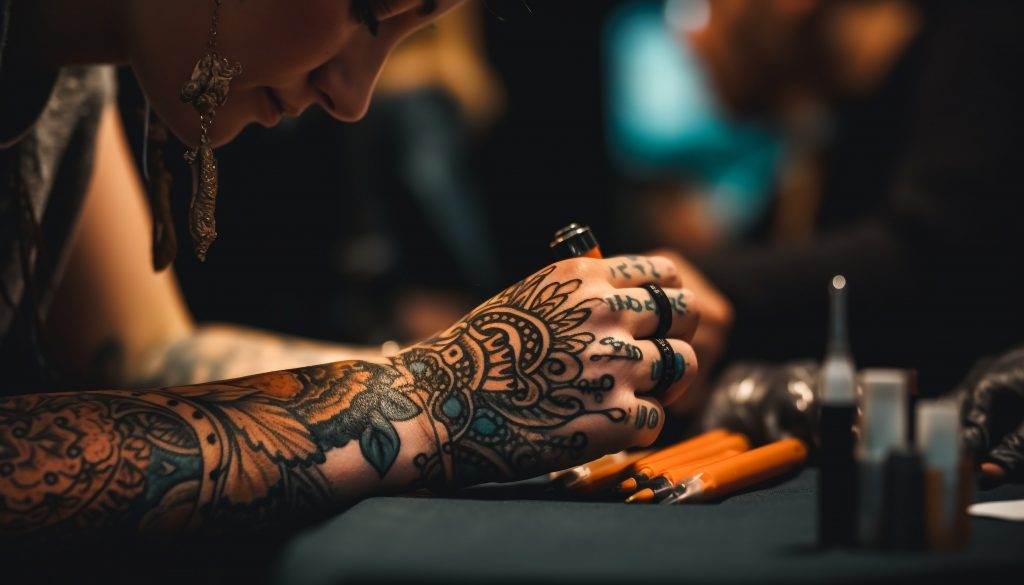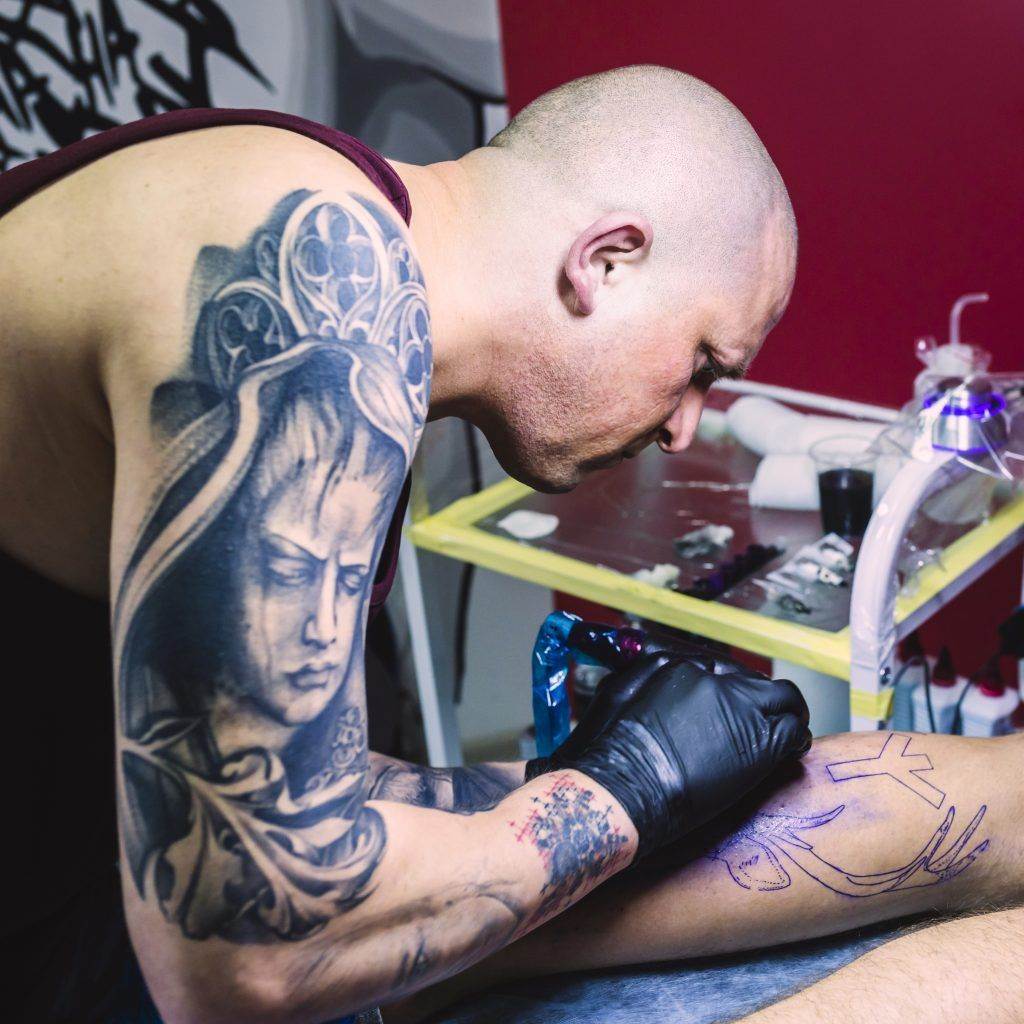Introduction
Brief History of Tattoos
The history of tattoos stretches back thousands of years, woven into the very fabric of human culture. Archaeological evidence suggests that tattooing practices originated as early as 3370 BC, with mummies discovered in Europe and Asia exhibiting intricate body art. These early tattoos were often made with natural dyes, using primitive tools, which reflects the human penchant for self-expression and personal identity.
- Cultural Significance: In ancient Egypt, tattoos were often associated with fertility and protection, while in other cultures, they signified social status or warrior prowess.
- Terminology: The word “tattoo” itself stems from the Tahitian word “tatu,” which means “to mark.” This highlights the connection between marking the body and cultural identity.
The advent of tattooing techniques varied wildly across regions. For instance, in Polynesian cultures, tattoos served a pivotal role in rites of passage, bravery, and beauty, as each marking told a story. The historical journey of tattooing showcases how it transformed from a tool of identity for tribes to a popular form of art celebrated globally today.
Significance of Tattoos in Different Cultures
Tattoos have held various meanings across cultures, serving not just as decorations but as powerful symbols of tradition, belief, and personal journey. From the spiritual symbols of indigenous tribes to the modern era’s diverse styles, each tattoo can represent something uniquely personal or culturally significant.
- Tribal Tattoos: In various indigenous cultures, tattoos are seen as a rite of passage or spiritual connection. For example, the Māori of New Zealand use Ta Moko, a traditional practice where intricate designs represent a person’s lineage, social status, and achievements. These tattoos serve as living histories, telling stories of ancestors and tribal affiliations.
- Modern Interpretations: Today, tattoos have been embraced by many as a form of personal expression. For some, they symbolize significant life events, relationships, or beliefs.
The expanding acceptance of tattoos reflects broader cultural shifts around individuality and self-expression.
- Diversity in Designs: Globally, tattoo styles have evolved to encompass a wide range of influences, including:
- Traditional Japanese: Known for its colorful and detailed motifs, often depicting elements like waves, koi fish, and cherry blossoms.
- Western Traditional: Characterized by bold lines and vibrant colors, often featuring symbols like anchors, skulls, and roses.
- Geometric Patterns: Gaining popularity in recent years, these tattoos focus on shapes and lines to create stunning visual art on the skin.
The negotiation of tattoo significance in different cultures enhances their allure, allowing individuals to connect with various layers of meaning while adorning their bodies. As tattoos continue to evolve, they embody an expansive narrative of humanity’s quest for identity and expression.

Early Forms of Tattooing
Ancient Tattoo Techniques
As we explore the origins of tattooing, it becomes clear that ancient civilizations developed a fascinating array of techniques to create their body art. The methods varied greatly, influenced by cultural practices and available resources, yet the core intention remained the same—marking the skin to convey meaning. One of the earliest tattooing techniques involved using sharp implements, such as thorns or bone needles, to puncture the skin and introduce pigments or soot. For instance, in various tribal settings, tattoos often utilized natural materials found in their environment:
- Pigmentation Sources: Commonly used inks derived from:
- Charcoal
- Clay
- Plants (e.g., indigo)
These pigments were meticulously prepared to ensure permanence, with artisans displaying impressive skills that would be passed down through generations. Another prevalent method involved the use of the “stick and poke” technique, where a pointed stick was dipped into dye and then repeatedly poked into the skin to form designs. This rudimentary yet effective method is echoed in modern hand-poking styles, reflecting a return to the origins of tattoo art. The diverse styles of ancient tattoos also tell us much about the values and beliefs of different societies. For example, some cultures believed that tattoos served as protective charms or spiritual symbols, meant to guard against evil spirits. Others utilized tattoos to commemorate significant life events or achievements, marking transitions from one phase of life to another.
Archaeological Discoveries of Early Tattoos
Archaeologists have unearthed compelling evidence of ancient tattooing practices, enriching our understanding of this significant art form’s heritage. One of the most notable discoveries occurred in the early 20th century with the mummified remains of Ötzi the Iceman, a natural mummy from about 3300 BC, found in the Alps. His body revealed over sixty tattoos, primarily made with coal, highlighting tattooing’s longstanding presence in human history. Additionally, findings in various ancient burial sites have shown that tattooing was widespread across different cultures:
- Egypt: Hieroglyphics depict women with tattoos that denoted fertility and protection.
- Polynesia: Tools and designs discovered in archaeological sites reflect the deep spiritual connection and storytelling through tattoo art.
These archaeological discoveries illustrate that tattooing was not merely decorative; it played a crucial role in the identity and social structures of ancient peoples. The continuation of these practices in modern times reminds us of our shared humanity and the desire to express ourselves through art. The evolution of tattooing from these ancient roots to contemporary styles signifies a rich legacy that continues to inspire and engage individuals around the world. As societies evolve, so do their tattoos, weaving a complex tapestry of personal and cultural narratives that resonate with both tradition and innovation.

Evolution of Tattooing Tools
Traditional Tattooing Instruments
Stepping further into the evolution of tattooing tools, we find ourselves intrigued by the traditional instruments that ancient artisans used to create body art. These rudimentary tools represent the ingenuity and creativity prevalent in early tattooing practices, as cultures across the globe adapted their resources to form distinct styles. Traditional tattooing methods often relied on simple yet effective instruments:
- Needles: Ancient tattoo artists often used sharp objects made from bone, metal, or even thorns. For example, in Polynesia, artists utilized fish bones as needles, which were dipped in natural pigments to create intricate designs.
- Hand-Poked Technique: Instead of machines, the hand-poked method involved repeatedly inserting the needle into the skin, a labor-intensive approach but one that allowed for great control. Many indigenous cultures employed this technique, embedding deep symbolism in every poke.
- Tattooing Stick: Also known as a “tattooing comb,” this tool was used in traditional practices, especially in cultures like the Māori. The stick had multiple sharp points, allowing artists to create patterns rapidly.
Despite their simplicity, these traditional instruments laid the foundation for tattoo artistry, emphasizing the connection between technique and cultural significance.
Modern Tattoo Machines
Fast forward to the modern era, and we observe a remarkable transformation in tattooing tools. The invention of electric tattoo machines revolutionized the industry, enhancing efficiency and precision. Today’s machines cater to a wide range of styles and techniques, bridging the gap between ancient practices and contemporary art.
- Types of Modern Machines:
- Rotary Machines: These machines use a rotating motor to create smooth and consistent lines. Artists appreciate them for their versatility, allowing for both lining and shading.
- Coil Machines: Utilizing electromagnetic coils, these machines produce a rhythmic hammering action that punctures the skin. They are famous for their powerful performance and are preferred for more intricate designs.
- Adjustable Speed and Pressure: Modern machines offer various settings, enabling tattoo artists to customize their approach based on the client’s skin type and the intended design. This flexibility improves both the artistry and comfort of the tattooing process.
- Quality of Inks and Needles: Advancements in ink formulation and needle design have also contributed to the evolution. Contemporary inks are not only more vibrant but also safer for the skin, reducing allergic reactions and improving healing times.
The evolution from traditional to modern tattooing tools has allowed artists to create increasingly sophisticated and diverse designs. As technology continues to develop, the artistry of tattoos will likely expand further, reflecting the dynamic interplay between tradition and modernity in this ancient form of expression. The journey of tattooing tools underscores a continuous narrative of innovation, creativity, and shared human experience through art on skin.

Cultural Influence on Tattoo Designs
Traditional Tribal Tattoos
As we delve into the rich tapestry of tattoo designs, it becomes evident that cultural influences have played a vital role in shaping the styles and symbols that adorn the skin. Traditional tribal tattoos are perhaps the most significant representation of this cultural interplay, as they are steeped in history and tradition. Tribal tattoos, often unique to specific geographic regions, serve as vivid markers of identity, belief systems, and communal ties. For instance:
- Maori Tattoos (Ta Moko): Originating from New Zealand, these tattoos feature intricate patterns that signify social status, lineage, and personal achievements. Each design is unique, telling a story about the bearer’s identity.
- Samoan Tattoos (Tatau): In Samoan culture, tattoos are seen as a rite of passage. They often cover large sections of the body and feature geometric patterns with deep cultural meanings, reflecting the wearer’s social standing and familial ties.
- Native American Tattoos: Various tribes, such as the Lakota and Haudenosaunee, used tattooing for spiritual purposes and as a rite of passage. Designs often included animals, symbols, and natural elements that represented strength, valor, and connection to nature.
The significance of these tribal tattoos goes beyond mere aesthetics; they encapsulate a person’s heritage while fostering a sense of belonging within their community.
Contemporary Tattoo Styles Across the Globe
As tattooing has evolved, so too have the styles that emerge from cultural influences around the world. Contemporary tattoo art now embodies a fusion of traditional elements with modern trends, reflecting a globalized society where boundaries of cultures often blur.
- Realism and Portraiture: This style focuses on creating lifelike portraits or depictions that mirror photography. It has gained immense popularity worldwide, showcasing an artist’s ability to capture intricate details, emotions, and lifelike qualities.
- Watercolor Tattoos: An artistic trend that’s emerged recently, watercolor tattoos utilize bright colors and flowing designs that mimic the look of a watercolor painting. This style breaks from traditional outlining techniques, making it fluid and ethereal.
- Japanese Irezumi: Traditional Japanese tattooing remains a major influence today, characterized by vibrant colors and detailed imagery, often including koi fish, dragons, and cherry blossoms. This style maintains its cultural significance while being embraced globally.
- Geometric Designs: These tattoos utilize shapes and lines to create captivating patterns, often emphasizing symmetry and intricacy. This modern aesthetic appeals to a wide audience and has become popular across various cultures.
The blending of these contemporary styles with traditional roots illustrates the dynamic nature of tattooing as an art form. As societies evolve, tattoos continue to serve as a canvas for cultural expression, personal storytelling, and artistic exploration. Each tattoo, regardless of its origins, tells a unique story, allowing individuals to connect with their past while celebrating their present identity in a constantly changing world. The exploration of cultural influences in tattoo designs highlights the beautiful interplay between history and modernity, creating an ever-expanding landscape of artistry on the skin.
Tattooing Practices Around the World
Different Tattooing Rituals
As we explore tattooing practices across various cultures, it becomes apparent that the art of tattooing goes beyond mere skin art; it is often intertwined with deeply rooted rituals and significant cultural practices. These rituals can vary dramatically in purpose and significance, but each adds a profound layer of meaning to the act of getting tattooed. Many cultures use tattooing as a rite of passage. For example:
- Samoan Tatau: This traditional practice involves an intricate and painful process where young men undergo extensive tattoos, marking their transition into adulthood. The ceremony surrounding the tatau includes the participation of family and friends and symbolizes becoming an esteemed member of society.
- Māori Ta Moko: In Māori culture, getting tattooed is not only an artistic expression but also an important spiritual experience. The process often occurs in a sacred setting and may involve chanting or the reciting of prayers. Each design holds meaning, celebrating ancestry and identity.
- Japanese Irezumi: Traditionally, irezumi was associated with the yakuza, Japan’s organized crime syndicate. Over time, however, it has evolved into a broader cultural practice, with people undergoing elaborate tattooing rituals that can take years to complete. The process is often accompanied by customs that honor the significance of each design.
Rituals surrounding tattoos help strengthen community bonds and celebrate individual identity, forging a unique connection between the wearer, the artist, and the culture itself.
Tattoo Taboos in Various Cultures
Interestingly, with the significance of tattoos come various taboos that can influence perceptions and practices around tattooing in different societies. While some cultures embrace tattoos as symbols of strength, beauty, or belonging, others may view them with caution or outright disapproval.
- Religious Views: In some cultures, religious beliefs discourage or prohibit tattooing. For instance, in certain interpretations of Christianity and Islam, marking the skin can be seen as contrary to teachings regarding the sanctity of the body. Traditional Jewish law also typically forbids tattoos.
- Social Stigma: In many Eastern and Western societies, tattoos can carry stigmas that associate them with rebellion or criminality. Even today, individuals from cultures where tattoos are less accepted may face discrimination or judgment.
- Cultural Appropriation Concerns: A growing conversation around tattoos includes the concern of cultural appropriation. When individuals adopt designs from cultures that are not their own without understanding the significance or context behind those symbols, it can lead to tensions and disagreements.

Understanding these taboos provides insight into the complexities of tattooing practices globally. While tattoos serve as platforms for expression and culture, they can also reflect broader societal norms and challenges. In conclusion, tattooing practices around the world are rich and diverse, steeped in rituals and cultural significance. These practices not only celebrate individual stories and identities but also underscore the importance of respecting cultural roots and navigating taboos that shape perceptions of this ancient art form. As tattoos continue to inspire and provoke discussion, they remind us of the powerful connections between body art and culture, bridging the gap between history and contemporary expression.
